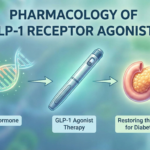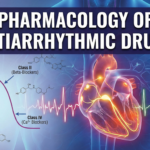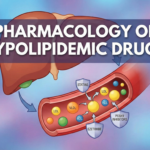Clindamycin is a lincosamide antibiotic widely used for its excellent activity against many Gram-positive cocci and anaerobes. It is valued for oral and parenteral versatility, tissue penetration (including bone), and its toxin-suppressing action in severe streptococcal and staphylococcal infections.
Chemistry & Mechanism
Clindamycin is a semi-synthetic chlorinated derivative of lincomycin. It binds to the 23S ribosomal RNA of the 50S subunit, blocking peptide bond formation and translocation, thereby inhibiting protein synthesis. This results in generally bacteriostatic action, though it can be bactericidal against some streptococci and staphylococci at high concentrations.

Spectrum of Activity
- Gram-positive aerobes: Streptococcus pyogenes, viridans streptococci, and Staphylococcus aureus (including some MRSA, if susceptible).
- Anaerobes: Many, especially above the diaphragm (Peptostreptococcus, Clostridium perfringens, Cutibacterium acnes). Activity against Bacteroides fragilis is variable due to regional resistance.
- Lacks activity against Enterococcus, most Gram-negative aerobes, and Clostridioides difficile.
Clinical Uses
- Skin/soft tissue infections: Including MRSA if the isolate is susceptible.
- Anaerobic infections: Lung abscess, aspiration pneumonia, dental abscess.
- Bone/joint infections: Osteomyelitis, due to high bone levels.
- Gynecologic and intra-abdominal infections: As part of combination regimens.
- Bacterial vaginosis and acne: Topical formulations.
- Toxin suppression: Adjunctive use in necrotizing fasciitis and toxic shock syndrome.
Pharmacokinetics
- Oral absorption: ~90%, unaffected by food.
- Distribution: Excellent tissue and abscess penetration, reaches bone but poor CSF entry.
- Half-life: 2–3 hours; hepatic metabolism.
- Excretion: Primarily bile, some urinary.
Key Adverse Effects
- Diarrhea and C. difficile infection: Noted risk of severe/fatal colitis — monitor and discontinue if suspected.
- Others: Rash, GI upset, transient hepatic enzyme rise, rare neutropenia or allergic reactions.
Resistance & D-Test
- erm genes: Cause inducible or constitutive resistance (MLS_B phenotype).
- D-test: Used to detect inducible resistance in erythromycin-resistant isolates.
Drug Interactions & Precautions
- Antagonistic with macrolides (overlapping ribosomal site).
- Enhances neuromuscular blockade.
- Use cautiously in hepatic dysfunction (extend dosing interval if needed).
- In pregnancy and lactation, generally regarded as safe when benefits justify risk.
References
- Murphy PB, Adam GP, Stevenson B, et al. Clindamycin. StatPearls [Internet]. Treasure Island (FL): StatPearls Publishing; 2024 Feb 27.
- Brunton LL, Hilal-Dandan R, Knollmann BC, editors. Goodman & Gilman’s The Pharmacological Basis of Therapeutics. 14th ed. New York: McGraw-Hill; 2022.
- Johns Hopkins ABX Guide. Clindamycin. Updated 2024 Dec 13.
- Katzung BG, Vanderah TW, editors. Basic & Clinical Pharmacology. 16th ed. New York: McGraw-Hill; 2021.
📚 AI Pharma Quiz Generator
🎉 Quiz Results
Medical Disclaimer
The medical information on this post is for general educational purposes only and is provided by Pharmacology Mentor. While we strive to keep content current and accurate, Pharmacology Mentor makes no representations or warranties, express or implied, regarding the completeness, accuracy, reliability, suitability, or availability of the post, the website, or any information, products, services, or related graphics for any purpose. This content is not a substitute for professional medical advice, diagnosis, or treatment; always seek the advice of your physician or other qualified health provider with any questions you may have regarding a medical condition and never disregard or delay seeking professional advice because of something you have read here. Reliance on any information provided is solely at your own risk.









